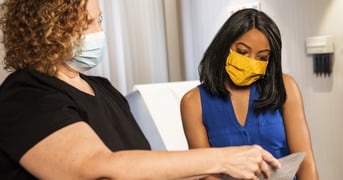What Patient Entertainment Systems Should Be
5 minute read | 02/11/2018

At its very heart, a patient entertainment system should be about its user - the patient. Personalised care and digitisation are major changes that will take place over the next five years as set out in the published NHS Long Term Plan.
Although the coronavirus pandemic expedited a lot of the steps towards more digitally-connected healthcare solutions, the majority of hospitals are still severely outdated. Here’s how patient entertainment systems should be in a post-COVID-19 world and how the NHS can improve on the current ones installed.
- Innovate Along With The NHS Long Term Plan
- Encourage Personalised and Accessible Patient Experiences
- Shape Future Decision-Making with Holistic Data
Innovate Along With The NHS Long Term Plan
In the early 2000s, hospitals introduced entertainment systems - many of which are still used in Trusts today. These bedside systems feature small screens that have to be wheeled across the ward or pulled out from the walls and repositioned on a moveable arm to get the desired viewing position.
Technology has improved tremendously since then and there are other ways to provide services to the palm of patient’s hands.
The NHS Long Term Plan aims to foster a newfound relationship between people, professionals, the health and care system and digital technologies. The pandemic has shown the gaps in present patient entertainment and although it's a far cry from the days of a single TV being wheeled in and stuck in the corner of the room or a radio being played for an hour in the evenings, there is an incredible selection of opportunities on the market at the moment.
The overwhelming majority of the public and NHS staff who reported increased use of technology said they had positive experiences - impressive given the severe pressure on the NHS. We know that modern-day patients are more comfortable with technology, regardless of their age or background. But what can we do to leverage this familiarity and improve patient care solutions?
It's essential to move with technological innovations that can help support these frameworks to make digital patient-centric approaches second nature. Many NHS Trusts are looking for a more cost-effective, user-friendly alternative.
Encourage Personalised and Accessible Patient Experiences
Digital technology and patient entertainment systems are just small steps towards accessible healthcare. As we recover from the biggest health crisis we’ve ever experienced, it’s clear technology can help contribute to patient-centred care in many ways - if implemented correctly.
Digital technology has enabled staff to communicate with patients in a way that’s comfortable and easy to understand. This can lower the barriers established by traditional healthcare provision by simply giving patients the means to communicate however they like, as well as educating them on their diagnosis and treatment in a way they can understand. Research shows that the sharing of information is crucial to improving patient experience.
Access to educational resources, including videos of diagnosis and tutorials allows the patient to take control of their own healthcare. It also means they can check on aspects of their healthcare without having to ask an NHS staff member (potentially disturbing them from their tasks) and allows medical practitioners to quickly bring up a digital window to their notes without needing to search for them.
For this to be achievable, there needs to be tailored digital services, platforms, infrastructure and standards in place. With all this innovation, it’s important to note the impact of COVID-19 will not be evenly felt across individuals of different socioeconomic status. Those who typically need access to tech, remote solutions and patient entertainment systems are the ones furthest from it.
As we look past coronavirus, clinicians should aim to develop strong patient education skills, more inclusive decision-making strategies and patient-centric tools. An engaging and informative patient entertainment system like marketing-leading SPARKⓇ Media, is an innovation that’s much easier and cheaper to improve experiences.
Shape Future Decision-Making with Holistic Data
Data, stats and analytics were an untapped opportunity in healthcare. Since recognising that, we’ve successfully seen some healthcare providers exploring digital technology and advanced analytic capabilities to improve operations through their patient entertainment systems.
Better use of data has the power to transform the quality of health and care services while reducing costs. Real-time data on patients with symptoms of coronavirus and hospital admissions is invaluable.
The use of tech will become indispensable when monitoring the demands for healthcare services.
With the implementation of a patient engagement platform available on people's own devices, comfort, happiness and recovery will improve.
This all works towards giving NHS staff back valuable time that can be spent elsewhere - on those who need more intensive care. SPARKⓇ Media has a variety of innovative functionalities that can help both the patient and the NHS staff. These include allowing patients to:
- Easily view live TV, music channels, games and a vast library of magazines for free, as well as access movies and albums to keep patients entertained.
- Access to electronic food menus and the ability to order their meals, avoiding wastage and ensuring patients with dietary requirements or nil-by-mouth are catered for.
- Request small ad-hoc requests such as an extra pillow or water. Usually, a nurse must attend all button presses by a patient. Now, a request can be fulfilled by anybody.
- View tailored education surrounding their conditions to aid their recovery. Better informed patients can make more knowledge-based decisions when it comes to their healthcare. This potentially reduces hospital visits in the future, lowering further costs.
- Fill in surveys directly from their device that can greatly improve the quality of your services and lead to a greater patient experience.
- Access WiFi and video call with family to avoid isolation during a challenging time and stay connected.
Each interaction a patient has on a patient entertainment system is another piece of valuable data that can be used to accurately staff, prevent errors and facilitate preventive care.
Throughout the COVID-19 pandemic, technology has played a vital role in ensuring services are maintained - this is only set to continue. From virtual appointments to patient entertainment, platforms provided by SPARK TSL have enabled procedures to continue.
Though the NHS has previously been slow to adopt and roll out new technologies, recent developments show it can do so at impressive pace and scale when needed. There’s no better time to make that change for your Trust.
Improve Healthcare by Improving Patient Entertainment Systems
Modern entertainment systems are a much more cost-effective option than the traditional bedside units. Solutions, like SPARKⓇ Media, can help. After all, entertained patients are happy patients and you want to make their time in hospital as easy and carefree as it possibly can be. Although, it can be challenging to know where to begin.
If you’d like to find out more about how hospital entertainment systems can benefit the NHS, book your demo below.
About the author
Rebecca O'Donovan
Becky is the Marketing Director at SPARK TSL, of whom she has worked for since 2012. She is responsible for high-level marketing strategy focusing on lead generation and aiding the vision of the business to ensure business growth.
More articles by the author
Related articles
 Healthcare Industry
Healthcare Industry
Why Digital Tech Will Be Crucial to a Recovery in Healthcare
Digital technology uptake in healthcare has been long overdue. Now, digital communications and technologies ...
 Healthcare Industry
Healthcare Industry
How to Measure Patient Satisfaction Scores in the Covid Era
Patient satisfaction in the Covid era is a difficult topic for most healthcare professionals to broach. ...
 Healthcare Industry
Healthcare Industry
What's Next in Hospital Patient Entertainment Systems? | SPARK TSL
When hospitals started to offer television in the early 2000s, the government saw it as a triumphant drive ...


